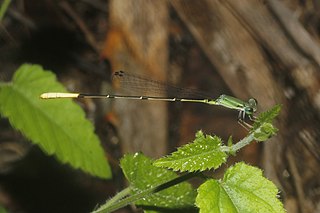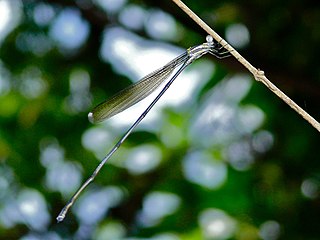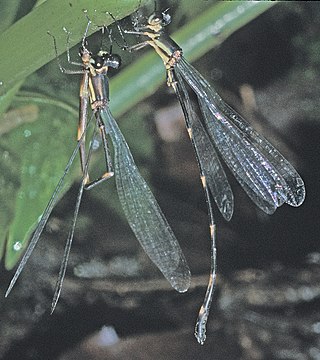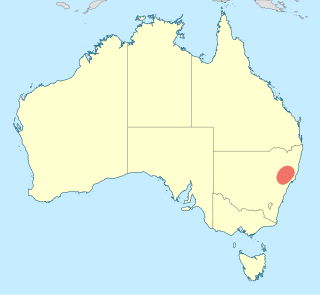Epigomphus is a genus of dragonflies in the family Gomphidae. They are commonly known as knobtails.

Gynacantha is a genus of dragonflies in the family Aeshnidae. The females have two prominent spines under the last abdominal segment. This gives the genus name and the common name two-spined darners; they are also known as duskhawkers.
Hypopetalia pestilens, the white-dotted redspot, is a monotypic species of dragonfly in the family Austropetaliidae. It is endemic to central Chile. Its natural habitat is rivers. It is threatened by habitat loss.

Leptobasis is a small genus of damselflies in the family Coenagrionidae. They are commonly known as swampdamsels. The genus is neotropical and one species, L. melinogaster, has been recorded in Texas. They are slender and the females have very long ovipositors.

Mecistogaster is a genus of large Neotropical damselflies in the family Coenagrionidae, commonly known as helicopter damsels. There are eleven species distributed from Mexico to Argentina.

Palaemnema is a genus of dragonflies in the family Platystictidae. They are commonly known as shadowdamsels and are found in the New World, from Arizona to Peru and French Guiana.
Phyllopetalia altarensis is a species of dragonfly in the family Austropetaliidae. It is endemic to Chile. Its natural habitats are rivers and freshwater springs. It is threatened by habitat loss.

Phyllopetalia excrescens is a species of dragonfly in the family Austropetaliidae. It is endemic to Chile. Its natural habitats are intermittent rivers and freshwater springs. It is threatened by habitat loss.
Phyllopetalia pudu is a species of dragonfly in the family Austropetaliidae. It is found in Argentina and Chile. Its natural habitat is rivers. It is threatened by habitat loss.
Phyllopetalia stictica is a species of dragonfly in the family Austropetaliidae. It is endemic to Chile. Its natural habitat is rivers. It is threatened by habitat loss.

Progomphus is a genus of medium-sized dragonflies in the family Gomphidae. They are found in the Americas and are largely tropical. They are one of the few Gomphids with coloured wings.
Progomphus tennesseni is a species of dragonfly in the family Gomphidae. It is endemic to the Dominican Republic. Specimens of this species were first collected by Dr. Oliver Flint of the Smithsonian Institution near a waterfall of a tributary of the Rio Yaqui del Norte, west of Jarabaco. Daigle (1996) recognized this species from a large number of Progomphus collected, who distinguished its differences from a larger number of Progomphus serenus specimens. Its natural habitats are subtropical or tropical moist lowland forests and rivers. It is threatened by habitat loss. The species is named after Ken Tennessen, a well-known researcher of New World Odonata.

Perithemis is a genus of dragonflies commonly known as Amberwings. They are characterized by their small size and the amber wings of the male.

Orthemis is a genus of large Neotropical dragonflies, commonly called Tropical King Skimmers. The males are generally red and the females brown.

Micrathyria is a Neotropical genus of dragonflies. They have bright green eyes and white faces. Most species have a markedly striped thorax. They are commonly known as Tropical Dashers.

Cannaphila is a small Neotropical genus of dragonflies in the family Libellulidae. They are commonly called narrow-winged skimmers. One species, C. insularis, occurs in North America. There are three species.

Rhodopygia is a genus of dragonflies in the family Libellulidae. They are neotropical species, occurring in Guatemala, Belize through Bolivia and Brazil.

Miathyria is a Neotropical genus of dragonflies. They are commonly known as Hyacinth Gliders. One species, M. marcella, occurs in North America. They are associated with floating plants, especially Water Hyacinth or Water Lettuce.

Austropetalia annaliese is a species of dragonfly of the family Austropetaliidae, known as the northern redspot. It is endemic to mountain areas of north-eastern New South Wales, Australia, where sphagnum moss is abundant. It is a medium-sized dragonfly with brown and yellow markings, the female being similar to both Austropetalia patricia and Austropetalia tonyana.

Parasynthemis regina is a species of dragonfly in the family Synthemistidae, known as the royal tigertail. It is a medium to large and slender dragonfly with a long body and black and yellow markings. It inhabits stagnant pools and swamps in eastern Australia














